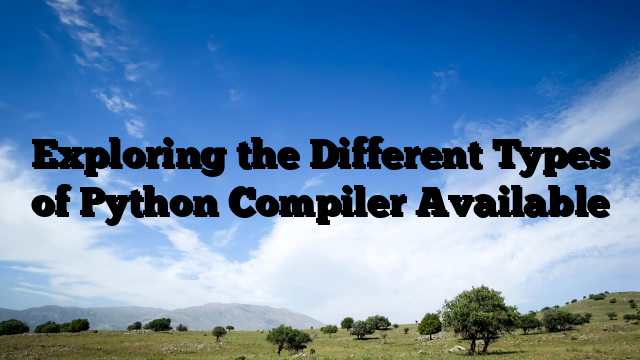Python Interview Questions: A Comprehensive Guide to Ace Your Interview
Introduction
As Python continues to gain popularity, it has become a go-to language for software developers and data scientists alike. If you’re preparing for a Python interview, you need to be well-prepared to tackle a variety of questions that assess your technical skills and problem-solving abilities.
In this article, we present an extensive collection of Python interview questions, ranging from basic to advanced topics. Each question is followed by a concise and insightful answer, giving you a solid understanding of the concepts involved. Whether you’re a fresh graduate or an experienced professional looking for a Python role, this guide is designed to help you excel in your interview.
The Basics: Python Fundamentals
1. What is Python, and what are its key features?
Python is a high-level, interpreted programming language known for its simplicity and readability. Its key features include dynamic typing, easy syntax, automatic memory management, and extensive standard libraries.
2. How is Python different from other programming languages like Java or C++?
Unlike Java or C++, Python is an interpreted language, meaning it doesn’t require compilation before execution. Additionally, Python emphasizes code readability, which reduces the development time significantly.
3. What is PEP 8, and why is it important?
PEP 8 (Python Enhancement Proposal 8) is the style guide for Python code. Adhering to PEP 8 ensures consistency and readability in your codebase, making it easier for other developers to understand and maintain your code.
4. Explain Python’s GIL (Global Interpreter Lock).
Python’s GIL is a mutex that allows only one thread to execute Python bytecode at a time. This means that Python threads cannot fully utilize multi-core processors for CPU-bound tasks. However, it simplifies memory management and makes it easier to develop thread-safe Python code.
Data Types and Data Structures
5. Differentiate between lists and tuples in Python.
Lists and tuples are both used to store collections of items, but the key difference is that lists are mutable (can be modified), while tuples are immutable (cannot be changed after creation).
6. How do you create a dictionary in Python?
Dictionaries are created using curly braces ({}) and key-value pairs. For example: my_dict = {"name": "John", "age": 30}.
7. Explain the difference between shallow copy and deep copy in Python.
A shallow copy creates a new object but references the same elements as the original, while a deep copy creates a new object with its own copy of the elements, recursively.
8. What is the purpose of the enumerate() function in Python?
The enumerate() function is used to iterate over a sequence while keeping track of the index of the current item.
Control Flow and Loops
9. How does Python handle exceptions?
In Python, exceptions are raised when an error occurs during program execution. You can use try, except, and finally blocks to handle exceptions gracefully.
10. Explain the usage of the range() function.
The range() function generates a sequence of numbers and is commonly used in loops. For example: for i in range(5):.
11. What is the purpose of the break statement in Python?
The break statement is used to exit a loop prematurely when a certain condition is met.
12. How do you use list comprehension in Python?
List comprehension is a concise way to create lists. For example: [x for x in range(10) if x % 2 == 0].
Functions and Modules
13. Define a lambda function in Python.
A lambda function is an anonymous function defined using the lambda keyword. For example: multiply = lambda x, y: x * y.
14. What are modules in Python?
Modules are files containing Python code that can be imported into other Python scripts. They help organize code and promote reusability.
15. How do you handle global variables in a function?
To modify a global variable within a function, use the global keyword. Otherwise, the function will create a new local variable with the same name.
16. What is the __init__ method in Python classes?
The __init__ method is a special method that is automatically called when an object is created from a class. It is used to initialize the object’s attributes.
Object-Oriented Programming (OOP)
17. What is inheritance in Python?
Inheritance allows a class (subclass) to inherit properties and methods from another class (superclass). It promotes code reuse and supports the concept of a parent-child relationship.
18. How do you achieve encapsulation in Python?
Encapsulation in Python is achieved by using private variables and methods (denoted by a leading underscore). This restricts direct access from outside the class.
19. Explain the difference between staticmethod and classmethod.
staticmethod is a method bound to a class and doesn’t have access to class or instance-specific data. classmethod, on the other hand, takes the class as its first argument and can access and modify class-level data.
20. What is method overriding in Python?
Method overriding allows a subclass to provide a specific implementation of a method that is already defined in its superclass. This allows customization of behavior for the subclass.
File Handling and Input/Output
21. How do you open and close a file in Python?
To open a file, use the open
() function with the file name and mode (read, write, etc.). Don’t forget to close the file using the close() method to release resources.
22. Explain the difference between reading a file in text mode and binary mode.
Text mode reads and writes strings, while binary mode reads and writes bytes. Binary mode is used when handling non-text files like images or audio.
23. How do you handle exceptions when working with files?
To handle exceptions when working with files, wrap the file operations in a try block and use the except block to catch any errors that may occur.
24. How can you write to multiple files simultaneously in Python?
You can use multiple file handles to write to multiple files simultaneously in Python. Open each file with a different handle and write data accordingly.
Advanced Python Concepts
25. What is multithreading in Python?
Multithreading allows multiple threads to execute concurrently within the same process. However, due to the Global Interpreter Lock (GIL), Python threads are not suitable for CPU-bound tasks.
26. Explain the use of decorators in Python.
Decorators are functions that modify the behavior of other functions. They are often used for code reuse and adding functionality to existing functions.
27. How do you manage dependencies in Python?
Dependency management in Python is typically handled using package managers like pip and package files like requirements.txt or Pipfile.
28. What is the purpose of virtual environments in Python?
Virtual environments create isolated environments for Python projects, allowing you to install project-specific dependencies without affecting the global Python environment.
Conclusion
In this extensive guide, we covered a wide range of Python interview questions that will help you prepare for your next interview with confidence. By mastering these concepts, you can showcase your expertise, demonstrate your problem-solving skills, and impress potential employers.
Remember, practice makes perfect. Take the time to understand each question and its underlying concepts. Combine theory with hands-on coding to solidify your understanding. With dedication and preparation, you’ll be well-prepared to excel in your Python interview and land your dream job.
============================================


















